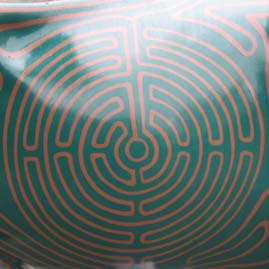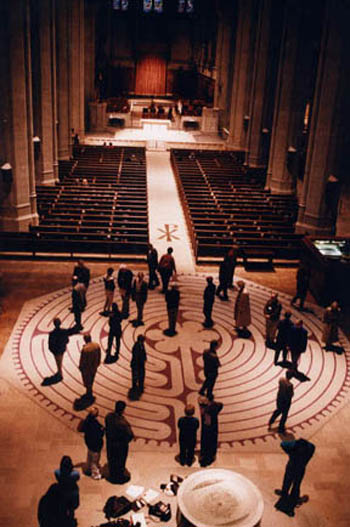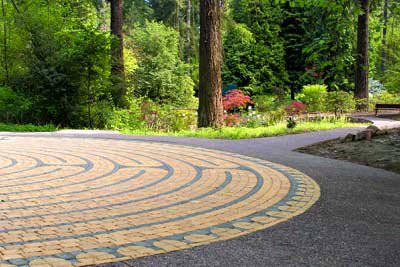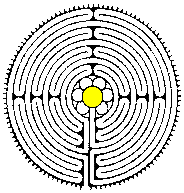Chartres Labyrinths
A labyrinth is a right brained task. It involves intuition, creativity, and imagery. With a maze many choices must be made and an active mind is needed to solve the problem of finding the center. With a labyrinth there is only one choice to be made. The choice is to enter or not. A more passive, receptive mindset is needed. The choice is whether or not to walk a spiritual path.

Chartres Labyrinth
The best known example of labyrinth is embedded in the stone pavement of Chartres Cathedral 50 miles southwest of Paris. The Middle Ages was a time of pilgrimages. People believed that if you walked the labyrinth with the full dedication of a pilgrim, you would be transformed, the old you will be grounded at the threshold stone a purified you emerging, ready to tackle new directions in your life's journey.
Here's a guy who either found meaning or made up stuff.

Everett Labyrinth
I think this is a pearls-before-swine sort of oddity—a Chartres labyrinth in Wiggums Hollow Park in a low-income neighborhood of immigrants in Everett, Washington. More an unsung paved area and less a hidden gem, no one in Everett seems to know what it is. I've never seen anyone walk it. Their website describes it as public art, and there's a picture of people walking it, which might have been staged for all I know. There is a nice bench opposite the entry to the labyrinth, and a view of the Snohomish River. Except for the need to sweep it off from time to time, it's a pleasant surprise. Except for the chewing gum dots, and the adjacent bathroom that recently burned down. Those aren't pleasant surprises.

Boston Cowbyrinth
In Boston in the summer of 2007, there were art cows all over town. This one has a Chartres-style labyrinth painted on it. In fact, it has many.

Grace Cathedral, San Francisco
Grace Cathedral has two labyrinths, one inside and one outside. The indoor one is in a cleared area for people to walk it whenever they want. At Chartres Cathedral in France, the labyrinth is covered with chairs all but four times a year, as it is considered a distraction from the Church's teachings, installed at a time (in the 13th century) when building a congregation meant appealing to traditions older than Christianity. At Grace, they have no such rigid mindset, and encourage people to use any means to enlightenment they can find.
It's crowded, and people walk slowly, which adds an individual (and sometimes annoying) aspect to walking it. Even when there are a few people on it, it seems intrusive to share.
Is the lesson that sometimes a metaphor for something annoying is as annoying as the thing? Or that you get more clarity and fewer dawdlers if you simply go outdoors? That going inside yourself can't be done if you have to dodge other seekers or coordinate your walk?

The Grotto, Portland, Oregon
Linda Gabriel discovered this one in Portland at a place called “The Grotto,” the popular name of The National Sanctuary of Our Sorrowful Mother. Jury's still out deciding which name is less appealing. Grotto. Sorrowful Mother. Grotto. Sorrowful Mother. I give up. Go walk the nice labyrinth and muse on that instead. Here's Linda's feets.

Inter-faith Garden Labyrinth at Grace Cathedral, San Francisco, California
This one is outside the cathedral, the same 42' diameter 11 circuit pattern. There's little traffic and it can be walked any time of the day or night. It's lighted all night. I used to go there and take off my shoes and walk it in the middle of the night.

Finger Labyrinth
You can carry a Chartres labyrinth in your pocket and trace the path any time you want. These bronze models come with a stylus for tracing the grooves.

Here's the path.
(from Lessons 4 Living) The most basic metaphor for walking a labyrinth is that of Life’s Journey. Walk the labyrinth while mindful of your life. Envision your life’s goal. Walk to your destiny and see what you learn. Pay attention to the sights and sounds. Do you feel lost at any time? If so, where in the labyrinth did it occur? What does that mean? Do you like one part of the labyrinth more than another? Why? What do the turns represent in your life? Do you resist some turns and like others. When you are outdoors notice subtle changes in the terrain – the ups and downs. Notice any synchronicities such as an overheard word or a bird’s song.
Consider all of your experiences in the labyrinth in relation to your life’s journey. Walk alone and then journal your experience. Walk with a group and then share your experiences. What does the labyrinth teach you about your life?
Here's a little questionaire for you to render your opinions about labyrinths.
